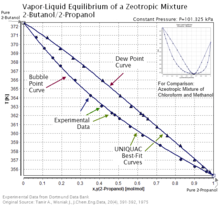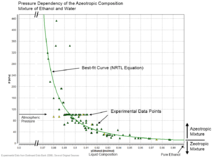Zeotropic mixture

.png)
A zeotropic mixture is a chemical mixture that never has the same vapor phase and liquid phase composition at the vapor–liquid equilibrium state. The dew point and bubble point curves in the graph shown do not touch each other over the entire composition range, with the exception of the pure components (the curve end points). Azeotropic describes mixtures in which the dew point and bubble point curves are touching each other at at least one point – indicating the same composition in the vapour and liquid phase.
Vapor pressures and boiling temperatures of a zeotropic mixture are always between the pure component boiling points resp. vapor pressures. Azeotropic mixtures show a pressure maximum/temperature minimum or pressure minimum/temperature maximum that is above/below the values of the pure components.
Stating compositions of zeotropic mixtures is common for some commercially available blends but the term zeotropic is valid only for a given temperature and pressure, not for specific compositions.
Relevance
Zeotropic mixtures can be separated by normal distillation. The separation factor never becomes exactly 1, but might be very close to 1, making a separation by distillation very difficult or even technically impossible.
Some specific zeotropic mixtures are used as refrigerants (Code names are R-4xxx). Zeotropic mixtures have the disadvantage that their composition changes during the repeated evaporation and condensation processes. This causes a temperature glide – a change in the boiling temperature at constant pressure. Additionally, this leads to changing thermodynamic properties, notably, heat of vaporization and heat capacity which are the most important in the refrigeration process. Azeotropic mixtures on the other hand have constant properties at their azeotropic composition and behave like pure components. If zeotropic blends are used, it is common to select mixtures with small separation factors (so called near-azeotropic mixtures).[2]
Occurrence

Zeotropy occurs when the boiling difference is large, or when the chemicals in a blend are similar, e. g. two ketones or two amines. Azeotropy occurs if the boiling point difference is smaller and the chemicals contain different functional groups (e. g. chloroform and methanol).
A mixture can be both zeotropic and azeotropic because the azeotropic composition changes with temperature and pressure. A good example is the mixture of ethanol and water, which is azeotropic above approximately 305 K (32 °C; 89 °F) and 12 kilopascals (1.7 psi). Below that temperature and pressure, the mixture is zeotropic. The separation factor at the limiting temperature is still very small, and thus the differences between liquid and vapor composition is too small to be of use for distillation.
External links
- Zeotropes as replacement for refrigerants by Laura Atkinson Schaefer
- Statistics about frequency of zeotropic and azeotropic mixtures in current literature (from Dortmund Data Bank)